 |
|
| The Return of the Star Spangled Grand Prix | |
| by Ewan M. Tytler, U.S.A. | |
|
It has been seven long years since a Grand Prix has been held on a United States soil, and with constant rumours of its return, sleepy hopes of motor-racing fans in the Home of the Brave are slowly but surely being awakened, and the mind wanders in yearns of times when the Formula One circus will pay us a visit. But it's not just fans that are beginning to save up for a Grand Prix ticket - it's track owners, sponsors, memorabilia sellers - all are starting to calculate the possible fortune. For the financial pay-off for the future host of the US Grand Prix could be enormous; gross earnings are predicted as high as $45 million for the organisers and $200 million for the host city. All this, provided that the Grand Prix will find itself a permanent venue to call its US home.
Promotion Formula One needs more promotion in the US before a Grand Prix can become an economically sound proposition. Formula One drivers - even Michael Schumacher and Mika Hakkinen - are not household names in the United States. One way to go about it, is to re-introduce the concept of a Transatlantic Race of Champions, consisting of the top twelve finishers of the 1998 Formula One World Championship and the top 12 finishers in the 1998 CART series at a US circuit, such as Long Beach, one month before the Australian Grand Prix in 1999. However, this event alone will not be enough to re-establish Formula One if there is no long-term strategy. The Formula One sponsors could go a long way to help promote Formula One in the USA and ultimately they would be repaid for their efforts. This must be a long-term commitment, a half-hearted effort will fail. Sponsorship
The Formula One Calendar
Location In more ways than one, the location of a future US Grand Prix is critical. It must be close to a large metropolis with an interest in motor racing. The local government and businesses must support the project. The local economy needs to be booming. The area should be accessible. Good hospitals with trauma units must be in the area. The climate cannot be too extreme or unpredictable. The terrain should include hills with natural amphitheatres, like Brands Hatch and the Hungaroring. Land prices cannot be too high. The site may either be built on an existing circuit or purpose-built from scratch. To be economically viable, a new, purpose-built site must be multi-purpose, including perhaps a golf course, tennis courts, a conference center, a shopping center and hotels. In short, we could be talking about building a small town. The Proposed Circuits Las Vegas, Nevada
Indianapolis, Indiana Indianapolis is the home of motor racing in America. There are enough motor racing enthusiasts in the area to fill the raceway. Indianapolis is not too far from Montreal, so this would be a convenient stop in the Grand Prix calendar. The proposal is to add an infield section that would join part of the famous oval track. The Indianapolis Motor Speedway (IMS) president, Tony George, apparently has sufficient resources to make the $20+ million expansion possible. The IMS public relations office were good enough to answer my questions but a map of the proposed circuit is not available. I hate to doubt anyone's plans for involvement in Formula One but, realistically, what can be built on the infield of the Brickyard? Spectators would have a wonderful view of the entire circuit, but it would be as flat as Holland. There is a danger of creating another Magny-Cours which no one would be too thrilled about. Nonetheless, I hope I'm mistaken and I wish IMS the best of luck in their endeavour. Atlanta, Georgia
The main disadvantage is the distance from other Formula One circuits, but this problem would be solved if the Formula One calendar was changed to arrange Montreal, Atlanta, Interlagos and Buenos Aires as consecutive events, preferably in the spring. Although there is wide interest in motor racing in the South-East, there is limited interest in Formula One. Mercedes' expanding presence in neighbouring Alabama can only help, if they seize the opportunity. Perhaps Road Atlanta should get Atlanta's Ted Turner behind the project too. Turner is another media mogul with deep enough pockets to make a Grand Prix circuit a commercial success, especially if he backed it up with outstanding television coverage. Orlando, Florida The Walt Disney World Speedway at Orlando currently hosts an Indy Racing League (IRL) event at its oval track. Orlando has a wonderful climate but has a relatively flat terrain. While the Disney Corporation has vast enough resources to build a Grand Prix circuit from scratch and host an economically successful US Grand Prix, I can't get the image of Mickey Mouse out of my head. Some people have described circuits like Magny-Cours and the Hungaroring as "Mickey Mouse Circuits". Well, the venue for the next US Grand Prix might be the real thing... Images spring to mind of Johnny Herbert or Rubens Barrichello hitching a ride back to the pits on Dumbo after their engines expire. nevertheless, if Disney is being serious, so should we. But how they will reconcile the tobacco industry's sponsorship of Formula One teams with their children's products is another question. Watkins Glen, New York
But The Glen's fortunes are looking up and in recent years, The Glen has experienced a resurrection, hosting NASCAR and other events. So far, International Speedway Corp., the current owner of the Watkins Glen circuit, has not thrown its hat in the ring. The rest of the pack: Brandy Station, Virginia; Dallas, Texas; San Francisco and Los Angeles, California - they have all been rumoured to be potential US Grand Prix sites. None of these proposals are well publicised, leaving us guessing: Who is behind these proposals? Are these temporary circuits (which would be less than ideal) or purpose-built circuits (which would be very expensive)?
And the winner is... I'd like to see Watkins Glen win the honour of again becoming the home of the US Grand Prix, mainly because of its history, but also because it is a classic European-style circuit that could host yet again spectacular races. If we can't have Watkins Glen, my choice would be Road Atlanta, because it is too an interesting, European-style circuit. In reality, however, the slip of paper will probably read: IMS, Indianapolis. US race fans, start packing your bags - Indiana, here we come!
|
| Ewan M. Tytler | © 1998 Atlas Formula One Journal. |
| Send comments to: ewant@uab.edu | Terms & Conditions |
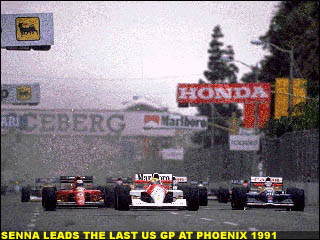 One of the main reasons for the US Grand Prix's demise some seven years ago, was the use of temporary circuits to host the event in the 1980's. The US Grand Prix became a Gypsy. Now, the renewed interest focuses in finding a new, permanent, home for the US Grand Prix. Several circuits have been proposed as potential hosts for the Grand Prix, starting as soon as the year 2000. Little concrete information is available about these proposed circuits, and each of them have pros and cons. Furthermore, several challenges will have to be met before Formula One can re-establish itself in the United States of America.
One of the main reasons for the US Grand Prix's demise some seven years ago, was the use of temporary circuits to host the event in the 1980's. The US Grand Prix became a Gypsy. Now, the renewed interest focuses in finding a new, permanent, home for the US Grand Prix. Several circuits have been proposed as potential hosts for the Grand Prix, starting as soon as the year 2000. Little concrete information is available about these proposed circuits, and each of them have pros and cons. Furthermore, several challenges will have to be met before Formula One can re-establish itself in the United States of America.
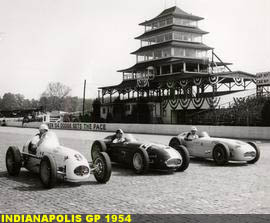 Since Renault and Peugeot have not exported a car to America in decades, it makes no economic sense for these manufacturers to seek publicity in North America. Ferrari, like Rolex, has never needed to advertise its products. However, it should be in the interests of Ford, Honda and Yamaha to advertise their involvement in Formula One. Moreover, the US market is very important to both Mercedes and BMW. Mercedes has recently opened a factory in Vance, Alabama, but none of their US adverts include footage of Mika Hakkinen or David Coulthard. Sponsors such as Boss, Castrol, Danka, Mobil, Pioneer, Sanyo, Shell and Texaco have not made use of their Formula One involvement in their US advertising either. Those companies need to start pushing Formula One more into the public awareness and promote Formula One in the States, at the very least for the sake of them reaping the rewards later on, when Formula One does become popular in the US.
Since Renault and Peugeot have not exported a car to America in decades, it makes no economic sense for these manufacturers to seek publicity in North America. Ferrari, like Rolex, has never needed to advertise its products. However, it should be in the interests of Ford, Honda and Yamaha to advertise their involvement in Formula One. Moreover, the US market is very important to both Mercedes and BMW. Mercedes has recently opened a factory in Vance, Alabama, but none of their US adverts include footage of Mika Hakkinen or David Coulthard. Sponsors such as Boss, Castrol, Danka, Mobil, Pioneer, Sanyo, Shell and Texaco have not made use of their Formula One involvement in their US advertising either. Those companies need to start pushing Formula One more into the public awareness and promote Formula One in the States, at the very least for the sake of them reaping the rewards later on, when Formula One does become popular in the US.
 With Bernie Ecclestone's plans to expand the Formula One calendar, a US Grand Prix can be easily added, on top of the current venues. Furthermore, the calender may benefit from making all the American races consecutive events. The ideal time of year for a US Grand Prix will obviously depend on its location - It can be boiling in Dallas and freezing in New York on the same day.
With Bernie Ecclestone's plans to expand the Formula One calendar, a US Grand Prix can be easily added, on top of the current venues. Furthermore, the calender may benefit from making all the American races consecutive events. The ideal time of year for a US Grand Prix will obviously depend on its location - It can be boiling in Dallas and freezing in New York on the same day.
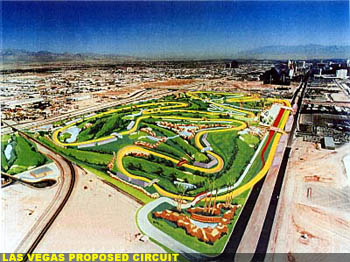 Las Vegas has hosted two Grand Prix in the parking lot of Caesar's Palace in 1981 and 1982. Their proposal was an ambitious 160 acre development that included a golf course across from the Strip at Las Vegas. However, the developers - Tommy Baker's US/GP-LV group - apparently ran into opposition from the local gambling industry, and the Clark County commisioners slowly killed the proposal. The commision finally approved a rival golf course proposal, so go figure... but Tommy Baker should not feel too bad - a rival proposal for a golf and tennis complex, endorsed by Andre Agassi, was also rejected.
Las Vegas has hosted two Grand Prix in the parking lot of Caesar's Palace in 1981 and 1982. Their proposal was an ambitious 160 acre development that included a golf course across from the Strip at Las Vegas. However, the developers - Tommy Baker's US/GP-LV group - apparently ran into opposition from the local gambling industry, and the Clark County commisioners slowly killed the proposal. The commision finally approved a rival golf course proposal, so go figure... but Tommy Baker should not feel too bad - a rival proposal for a golf and tennis complex, endorsed by Andre Agassi, was also rejected.

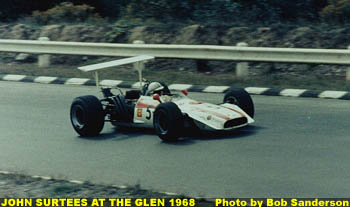
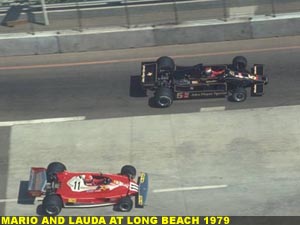 San Francisco or Los Angeles could be good choices. California has the biggest window of good weather for holding a motor racing event. A US Grand Prix in California could be scheduled before the Japanese Grand Prix. There are rumours that the Grand Prix Association of Long Beach (GPLB), or another organisation involving Chris Pook, have proposed four potential US Grand Prix sites. GPLB have not returned my phone calls to confirm or deny this rumour.
San Francisco or Los Angeles could be good choices. California has the biggest window of good weather for holding a motor racing event. A US Grand Prix in California could be scheduled before the Japanese Grand Prix. There are rumours that the Grand Prix Association of Long Beach (GPLB), or another organisation involving Chris Pook, have proposed four potential US Grand Prix sites. GPLB have not returned my phone calls to confirm or deny this rumour.